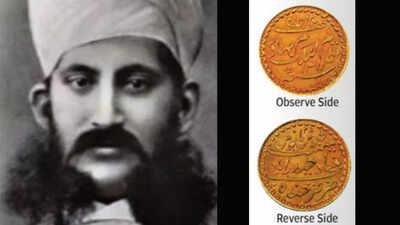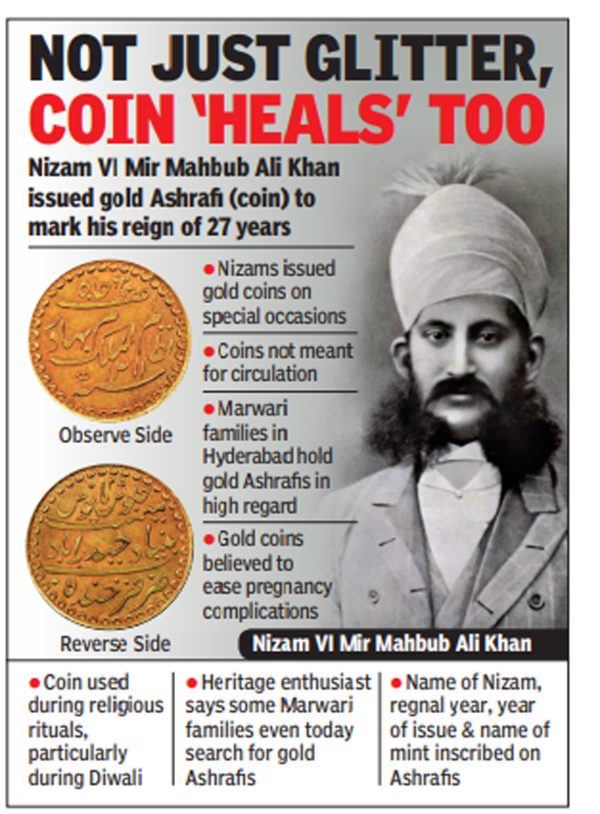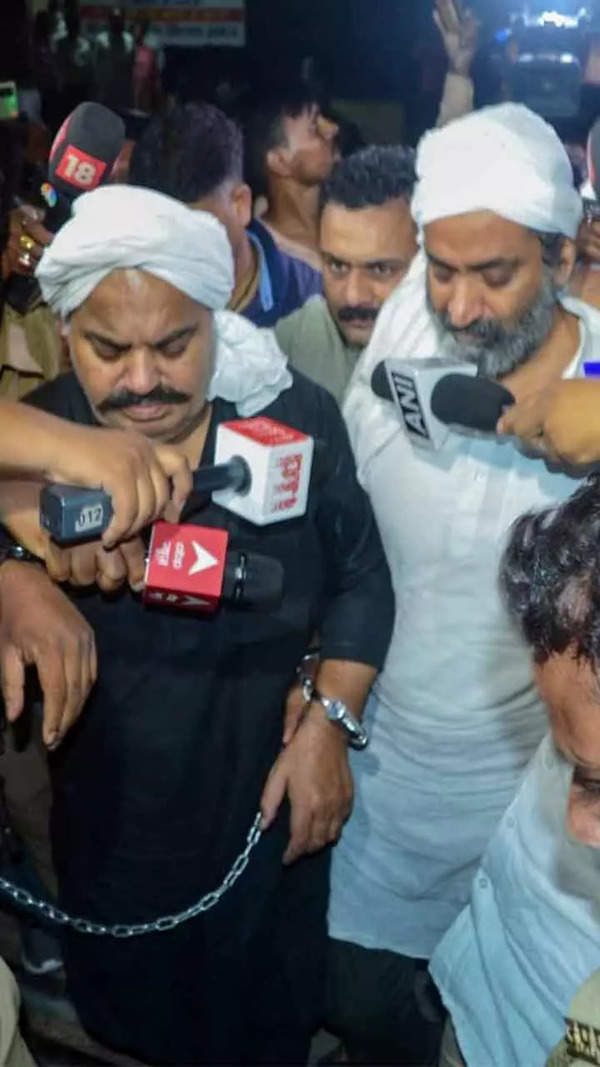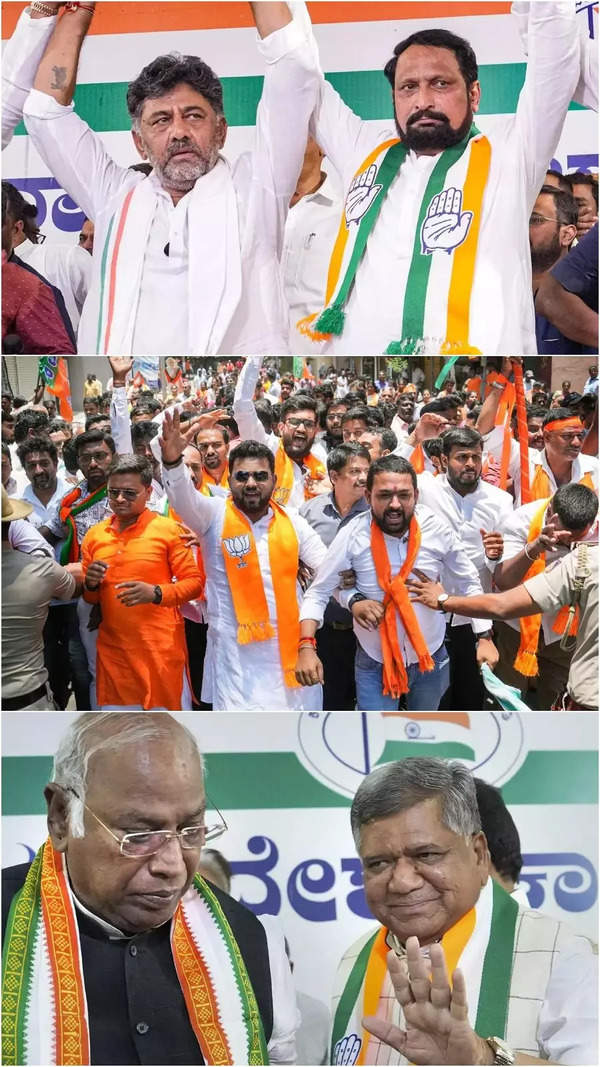- News
- City News
- Hyderabad News
- Myth & magic: Nizam-era gold coin’s craze for cure
Trending Topics
Myth & magic: Nizam-era gold coin’s craze for cure

Nizam VI Mir Mahbub Ali Khan issued gold Ashrafi (coin) to mark his reign of 27 years
HYDERABAD: A gold Ashrafi (coin) weighing about 11 grams issued by Nizam VI Mir Mahbub Ali Khan in 1311 Hijri (1893 CE) to mark his 27th regnal year is one of the most sought-after relics of the Asaf Jahi era. There are several traditional Hyderabadi Marwari families that hold this special coin in high regard. Some of them believe that the gold Ashrafi has magical powers and curative properties.
A few families still use the gold coin during Lakshmi pooja in Diwali. And a few others use the coin to reduce the labour pain. The coin is dipped in water overnight and the water is given to pregnant women as the belief goes that it helps in easy delivery and prevents complications.

Of all the Nizams, who ruled over the princely Hyderabad state, Mahbub Ali Khans holds a special place when it comes to the so-called spiritual powers. The Nizam VI was also known for his night outings in disguise to understand the problems of people first hand. During his lifetime he was credited with saving the lives of thousands of people, who were bitten by snakes or scorpions. Even today many people from traditional Hyderabadi families visit his grave in Mecca Masjid in Hyderabad and seek his blessings against toxins and poisonous creatures.
But what many do not know is the “magical powers” of the gold Ashrafi. Shree Prakash Loya, industrialist and heritage enthusiast, told TOI that some Marwari families even today search for the gold coins issued during the reign of Mahbub Ali Khan. “The coin is precious. It is believed that the presence of the coin helps in safe delivery of the child,” he said.
Stating why several traditional Hyderabadi Marwari families continue to hold the Nizam VI in high esteem, Prakash Loya, who hails from a Marwari family, which had migrated to Hyderabad from Rajasthan during the 19th century, said the Nizam had issued orders making Marwaris immune from arrests.
Amarbir Singh, eminent numismatist and heritage expert, said the Nizam VI had issued gold Ashrafis between 1311 AH and 1318 AH (corresponding to 1893 – 1900 CE) under Charkhi series. The name of the Nizam, the regnal year, year of issue and the name of the mint were inscribed on the Ashrafis, he said.
“My father explained to me that in the Nizam era the physically challenged were not charged in buses or railways. There was no sales tax and no income tax,” Prakash Loya said, adding that the only source of revenue was Kirodgiri (entry tax or customs duty, property tax and stamp duty).
Prakash Loya said the Nizam gave an assurance to the ruler of Jodhpur that Marwaris migrating to Hyderabad will enjoy an extra layer of protection and security.
“Even the police would not arrest them directly. The warrant or decree would have to be countersigned by a `Panch’ in different areas called 'Jhande Wale'. Only after a Panch from our community signed the decree, would it be effective when the accused was from our community,” he said, adding that on most occasions the Panch would settle the issue and arrest would be avoided.
A few families still use the gold coin during Lakshmi pooja in Diwali. And a few others use the coin to reduce the labour pain. The coin is dipped in water overnight and the water is given to pregnant women as the belief goes that it helps in easy delivery and prevents complications.

Of all the Nizams, who ruled over the princely Hyderabad state, Mahbub Ali Khans holds a special place when it comes to the so-called spiritual powers. The Nizam VI was also known for his night outings in disguise to understand the problems of people first hand. During his lifetime he was credited with saving the lives of thousands of people, who were bitten by snakes or scorpions. Even today many people from traditional Hyderabadi families visit his grave in Mecca Masjid in Hyderabad and seek his blessings against toxins and poisonous creatures.
But what many do not know is the “magical powers” of the gold Ashrafi. Shree Prakash Loya, industrialist and heritage enthusiast, told TOI that some Marwari families even today search for the gold coins issued during the reign of Mahbub Ali Khan. “The coin is precious. It is believed that the presence of the coin helps in safe delivery of the child,” he said.
Stating why several traditional Hyderabadi Marwari families continue to hold the Nizam VI in high esteem, Prakash Loya, who hails from a Marwari family, which had migrated to Hyderabad from Rajasthan during the 19th century, said the Nizam had issued orders making Marwaris immune from arrests.
Amarbir Singh, eminent numismatist and heritage expert, said the Nizam VI had issued gold Ashrafis between 1311 AH and 1318 AH (corresponding to 1893 – 1900 CE) under Charkhi series. The name of the Nizam, the regnal year, year of issue and the name of the mint were inscribed on the Ashrafis, he said.
“My father explained to me that in the Nizam era the physically challenged were not charged in buses or railways. There was no sales tax and no income tax,” Prakash Loya said, adding that the only source of revenue was Kirodgiri (entry tax or customs duty, property tax and stamp duty).
Prakash Loya said the Nizam gave an assurance to the ruler of Jodhpur that Marwaris migrating to Hyderabad will enjoy an extra layer of protection and security.
“Even the police would not arrest them directly. The warrant or decree would have to be countersigned by a `Panch’ in different areas called 'Jhande Wale'. Only after a Panch from our community signed the decree, would it be effective when the accused was from our community,” he said, adding that on most occasions the Panch would settle the issue and arrest would be avoided.

About the Author
Syed AkbarSyed Akbar is a senior journalist from Hyderabad. He is a specialist-journalist in science, technology, health, politics, environment, development, wildlife, religion, communities, and consumer affairs. He has been in the profession for the last 24 years. Before joining The Times of India, he worked with Deccan Chronicle and Indian Express.
Start a Conversation
FOLLOW US ON SOCIAL MEDIA
FacebookTwitterInstagramKOO APPYOUTUBE










